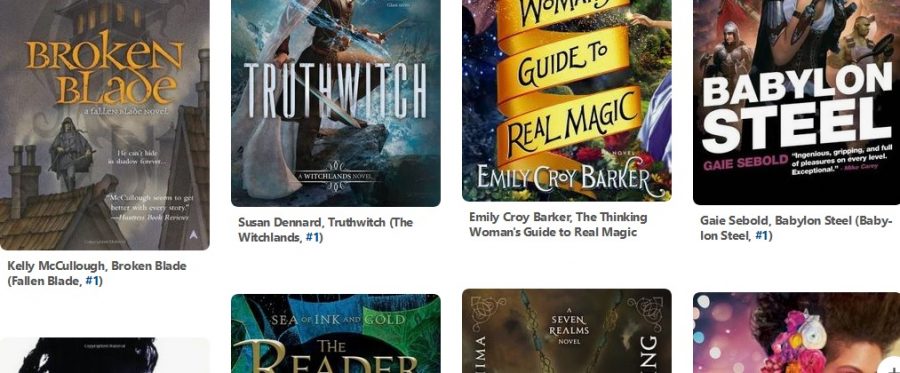29.08.19 – EC – article edited to clarify male authors account for about 55% of fantasy *titles*, rather than 55% of books, which could be misinterpreted as books *sold*. That is an entirely different discussion and outwith the scope of this post.
Some of you may know that I’ve had a little side-project on the go over the last year or so, called Beyond the Boys’ Club.
Fantasy as a genre has tended to present as by blokes, for blokes. Blokes tend to dominate the recommendations from bookshops, the shelves in airports, the best-of-year lists and all those 25 Fantasy Books To Read If You Liked Game of Thrones listicles. Despite this, male authors account for only about 55% of fantasy titles published in a year (as of the most recent authoritative stats I’ve got).
And if readers and writers challenge all those lists that skew so heavily male (bar a token Le Guin or Hobb), sure as sunshine someone will pop up in the comments with the tired old refrain of “But there’s just not that many . . .”
That sound you can hear? That’s my teeth grinding.
So I started Beyond The Boys’ Club out of sheer spite. I wanted a list that I could shove in the face of the next person to “not that many” me. I started with the fantasy books I owned or wanted to read that were not by men, then began paying attention to publisher announcements, recommendation threads on social media, and what my friends and follows on Goodreads were reading.
Then I put the results into a Google sheet, and as of today, 27th August 2019, I have a list of 653 fantasy authors who are not men. You can see them here.
Each entry has a Goodreads link to an example of the writer’s work, and the book’s GR genre tags. I even did a couple of simple charts that will update automatically as I add more data. And there will be more; I have a feeling I’m just getting started.
653 fantasy authors who are not men . . . I have a feeling I’m just getting started
Some takeaways from the list so far
Highlights that jumped out at me as I wrote this post:
- About 45% of the works listed are tagged YA, although there’s some crossover with middle-grade in that category, I note. This is by far the most populous subgenre in the list so far, but it’s still not the majority. That’s a genre myth busted – you know, the one that says only men write fantasy for adults.
- Only around 28% of the list is categorised as romantic. So much for another genre myth, that non-male authors only write romance.
- Just under 16% is categorised as epic/high fantasy.
- Over 9% has QUILTBAG themes.
- It trends series-heavy vs standalones, by about 3:1.
- Over 21% of the list was tagged as SF-ish by Goodreads users
- Anyone who says “I bet it’s all self-published” is getting a smack: 93% of the list is trad pubbed.
- I clearly need to add more columns – ‘fantasy of manners’ is starting to pop up, and I had to omit a whole bunch of others like ‘mythology’, ‘Arthurian’ etc. Maybe I need to add more hours to the day while I’m at it.
Obviously as the list grows, these figures will change, but I think 650+ is a reasonable sample from which to start seeing trends. At times like this, I kind of wish I still had access to the database & software development tools I used to work with in Ye Olde Day Jobbe. I could pull out much more complex reports on this dataset and have fun *for DAYS*.
But yeah. 653. Not that many of us at all, right?
Caveat emptor!
1) This sheet is a WORK IN PROGRESS. There are new authors being added to GR every day. Every week, publishers launch more debuts. I’ll try to keep up, but see above re: fallible human with limited time.
2) Let me be perfectly clear: this is in no way meant to be a rigorous statistical analysis of the genre. It was a project I started on the spur of the moment, purely for myself, and it will continue as long as I’m still having fun with it. I do not expect it to satisfy the internet rules-lawyers for whom no source is authoritative enough, no numbers hard enough, no lived experience valid enough – especially if it tells them something they don’t want to hear.
The crunchy stuff
Here’s all the TMI about my data source, limitations and assumptions.
Source
This list is compiled from Goodreads entries, and uses the GR genre tags listed under each book. This is the wisdom of crowds writ large, with all that that entails. I am entirely dependent on third parties for the quality of the data. For example: books that have 3000+ user tags have probably got their subgenres broadly correct. Books with only 20-odd shelvings? Eh, not so much. The smaller the sample, the greater the effect of outliers and user errors.
Books
For each author, I have listed one book to represent their work. This was either:
- the title that had been recommended
- where a series was recommended, the first book in the series
- where only the author was recommended, a title I had heard of
- where only the author was recommended and I had not heard of their work, a title that was well-rated on GR
Definitions
1) I have had to limit the number of columns I used, because GR is hardly prescriptive in its subgenres, and it was not practical to attempt to reproduce the same degree of granularity. SFF subgenre definitions are notoriously blurry anyway, so I took a broad-brush approach.
2) Every entry on the list has Fantasy as one of its genres.
3) Many books have been assigned genre labels on GR which amount to a dozen different ways of saying the same thing. For example:
- Fiction > Young Adult
- Fantasy > Young Adult
- Fiction > Young Adult > Teen
have all been counted in Column E as YA. I’ve done similarly with all varieties of Steampunk, Historical etc to keep the number of columns manageable.
In a similar vein, Epic Fantasy and High Fantasy were aggregated, and Dark Fantasy and Horror.
4) One particular column that has bugged me to no end has been the SF one. I’ve seen an awful lot of what I would class as traditional Epic Fantasy listed also as Science Fiction Fantasy. Is this different to fantasy with SF-nal elements, like time-travel or steampunk? Is this people just classifying all fantasy as a subgenre of Science Fiction, the way bookshops do sometimes?
I don’t know, and there’s no way tell, so if any variant of Science Fiction was included in the book’s genre list, it got a tick in that column.
Errors & Omissions
I have not read every book in the list, much as I would like to, and neither have I applied my own interpretations/used my discretion over genre tags. Any mistakes/omissions I will gladly hold my hand up to; I am, after all, only human and I have but one life to give.








